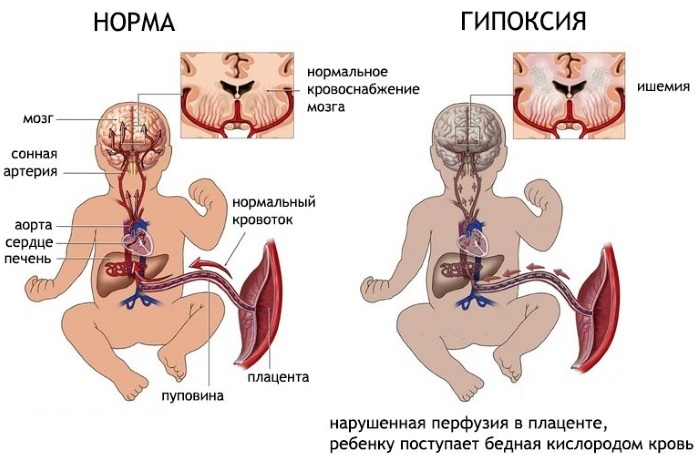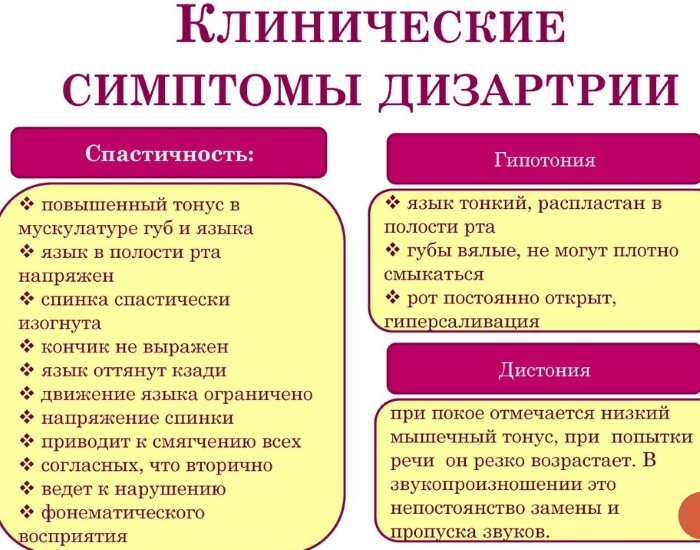Rinolalia is a pathological condition separate segments of the nasopharynx and oral cavity, the presence of which leads to a distorted pronunciation of vowels and consonants, violation of the basic functions of the speech apparatus, as well as a change in timbre sound vote.
In speech therapy, this disease is considered separately from all other defects in the development of speech. A distinctive feature of rhinolalia is the presence of nasal and nasalization of all sounds and words that are reproduced by a person suffering from this pathology.
Distortion of sound pronunciation is manifested in a weak or severe form. Words and sentences reproduced by a sick person are difficult for the people around them to understand. Pathology is accompanied by articulatory and acoustic speech defects.
Rhinolalia is characterized by a secondary violation of the development of vocabulary, phonemic processes and grammar. In speech therapy practice, this disease is considered quite common. On average, 1 out of 760 children is born with this impairment of the speech apparatus, or acquires it in the process of independent life.
Rinolalia is a speech therapy disorder, the main danger of which lies in the negative consequences associated with the improper formation of the speech apparatus. A person is deprived of the opportunity to reproduce sounds, to carry out the correct construction of words, phrases and sentences.
As the child grows up, his social adaptation in the team is disrupted, psychological complexes join, and low self-esteem is initially formed. In modern medical practice, rhinolalia therapy is carried out using surgical methods of treatment, upon completion of which the stage of speech therapy correction begins.
Record content:
- 1 Views
-
2 Stages and degrees
- 2.1 1st degree
- 2.2 2nd degree
- 2.3 Grade 3
- 2.4 4 degree
- 3 Symptoms
- 4 Reasons for the appearance
- 5 Diagnostics
- 6 When to see a doctor
- 7 Prevention
-
8 Treatment methods
- 8.1 Surgery
- 8.2 Speech therapy exercises
- 8.3 Psychological and psychotherapeutic assistance
- 8.4 Other methods
- 9 Possible complications
- 10 Rhinolalia video
Views
Rhinolalia in speech therapy is a disease that is classified based on the type of functional impairment of the speech apparatus, as well as pathologies in the structure of the nasopharynx and oral cavity. The table below lists the main types of rhinolalia, as well as describes their distinctive features.
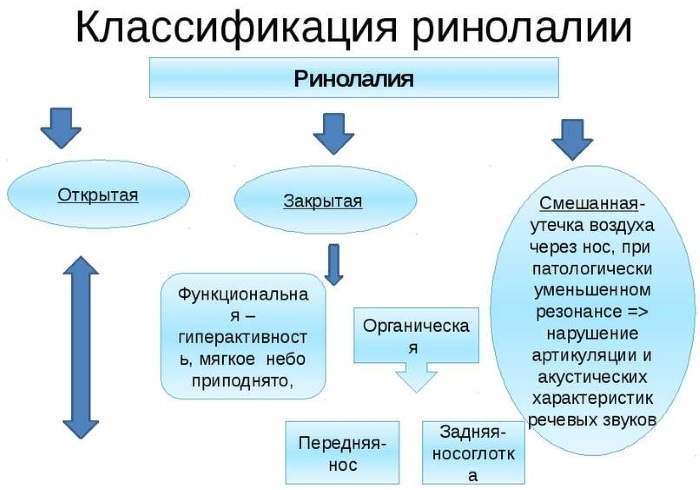
| Rhinolalia type | Characteristics of pathology |
| Open | Open rhinolalia is one of the most severe disorders in the development of the speech apparatus. Pathology is characterized by the complete absence of a physiological barrier between the oral cavity and nasal canals. During an attempt to reproduce words or individual sounds, a powerful stream of air is distributed between the mouth and the nasal canals, and should exit exclusively through the oral cavity. In this regard, there is a pronounced nasal resonance with a strong nasal speech. In most cases, the open type of rhinolalia is congenital, and its occurrence occurs even at the stage of intrauterine development. |
| Closed | Closed rhinolalia occurs in people in whose nasopharynx there is an obstacle that disrupts the process of air flow out during speech reproduction. This disease most often occurs in people suffering from adenoids, extraneous neoplasms in the nasopharyngeal cavity, severe curvature of the septum separating the nasal canals. Closed rhinolalia can be congenital and acquired in origin. |
| Mixed | Mixed rhinolalia is considered one of the most complex pathologies in the development of the speech apparatus. In people with this disease, there is a simultaneous defect in the formation of the opharyngeal ring and physiological obstruction of the nasal canals. Rhinolalia of this type is characterized by pronounced nasal speech and the complete absence of exclusively nasal sounds. |
| Organic | Organic rhinolalia is characterized by the presence of signs of abnormal development of the oral cavity. This pathology occurs in children with a split uvula, born with a cleft lip, and also the cleft palate, hidden clefts in the tissues of the soft palate, the complete absence of the uvula in the cavity sky. Restoration of the normal functions of the speech apparatus is possible only if these defects are eliminated using surgical methods. Organic rhinolalia, which was acquired in the course of life, occurs as a result of traumatic injuries of the oral cavity, as well as the tissues of the nasopharynx. In most cases, this type of pathology has a congenital etiology. |
Rhinolalia in speech therapy is a disease, the type of which is determined by the results of a diagnostic examination of the patient's oral cavity and nasopharynx. In newborns, pathology is found in the first days after their birth.
Stages and degrees
Depending on the form of speech impairment, the severity of distortion of words and sounds, there are 4 main degrees of severity of rhinolalia, regardless of the type of pathology.
1st degree
Rinolalia of the 1st degree has signs of slight nasalness of words with insignificant distortion of sounds. At the same time, the functions of the speech apparatus are preserved, and in the process of a conversation with a sick person, you can make out all the phrases that he reproduces. In general, the interlocutor's speech seems normal, but with minor defects.
2nd degree
In the presence of grade 2 rhinolalia, the nasal sound of words is more pronounced, and there are also gross errors during articulation. 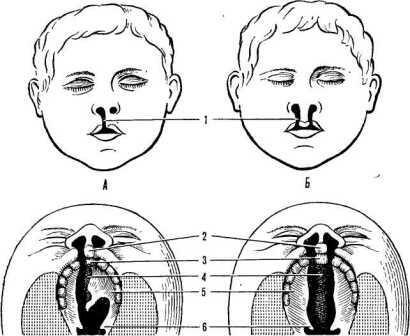 Communication with a person does not cause great difficulties, and his speech is completely understandable to others.
Communication with a person does not cause great difficulties, and his speech is completely understandable to others.
Grade 3
At this stage of the development of pathology, the patient has a pronounced nasal sound of sounds and words, but at the same time speech still retains its intelligibility. During a conversation with such an interlocutor, you can understand all the words that he utters. Discomfort in the perception of sounds is associated only with their nasal sound.
4 degree
In the presence of rhinolalia of the 4th degree, not only the nasalness of the reproduced words and sounds is added, but also problems with their identification appear. The speech of such patients is completely illegible. In some cases, people with a pathology of this severity use facial gestures to convey their thoughts to others.
Symptoms
Rinolalia in speech therapy is a disease accompanied by the following symptoms that make it possible to suspect the presence of pathology in the development of the speech apparatus:
- while feeding a newborn baby, breast milk or artificial mixtures flow out through the nasal canals (in this case, it is mono to talk about congenital open rhinolalia);
- the presence of gaps in the tissues of the palate, which lead to the ingress of cold air into the organs of the lower respiratory tract (in this regard, the patient has an increased tendency to frequent bronchitis, pneumonia, otitis media);
- weak intellectual abilities (children born with signs of rhinolalia often have concomitant diseases in the form of oligophrenia, hyperreflexia, mental retardation);
- abnormal course of the dolinguistic period, when the baby has no signs of babbling, articulation of sounds;
- reproduction of speech that is incomprehensible to most people around;
- very deaf and quiet voice, as well as nasal sounds;
- poor vocabulary, which is limited to a certain number of words that are most convenient for reproduction;
- anomalies in the development of the oral and nasal cavity, which are visible to the naked eye.
After the child grows up and enters a conscious age, he has a fear of communication, shyness and fear of being heard. Symptoms of rhinolalia, detected in early childhood, allow early treatment to begin with a positive therapeutic result.
Reasons for the appearance
Rhinolalia can be caused by the influence of negative factors during the period of intrauterine development of the child, or it occurs during the period of a person's independent life.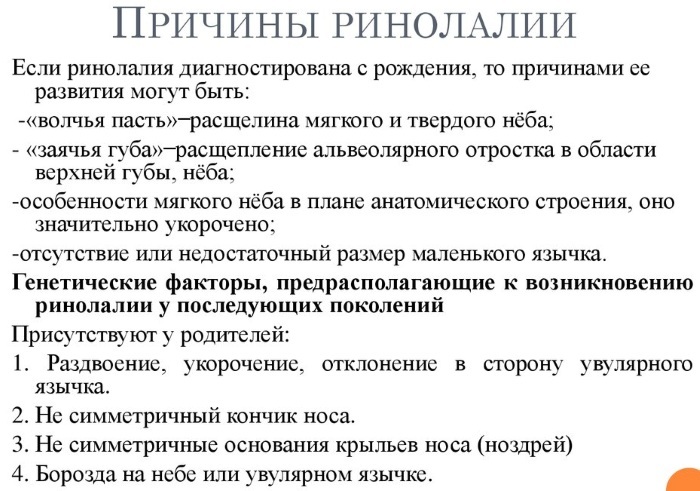
The following main causes of the pathological state of the speech apparatus are distinguished:
- infection of a pregnant woman's body with infectious agents that are causative agents of toxoplasmosis, mumps, rubella, influenza, syphilis (viral and bacterial microorganisms penetrate the placental barrier, after which they damage the tissues of the developing fetus);
- the use of alcoholic beverages during pregnancy, smoking and taking drugs;
- living in conditions of daily stress, when a pregnant woman is constantly in a state of nervous overstrain, which negatively affects the intrauterine development of the child;
- the presence of concomitant diseases of the endocrine system.
It has been scientifically proven that pregnant women living in areas with unfavorable environmental conditions, in contact with chemicals of toxic etiology, the risk of having children with signs rhinolalia.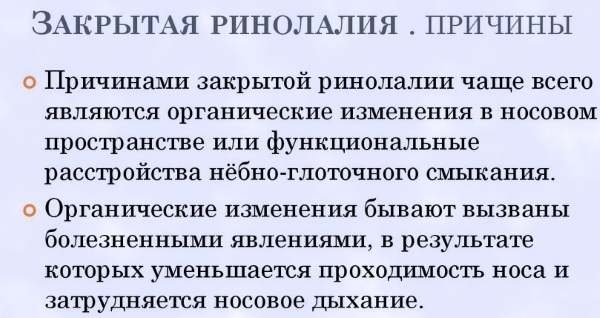
The development of facial clefts falls on the 7-8th week of pregnancy. It is during this period of gestation that a pregnant woman needs to be as careful as possible.
Acquired rhinolalia can be caused by adenoids, a deviated nasal septum, or a benign or cancerous tumor in the nasal canals, fibroma of the nasopharynx, hypertrophy of the mucous membrane, pathological enlargement of the tonsils, mechanical trauma and damage nasopharynx.
The reason that caused disturbances in the development of the speech apparatus is established according to the results of a diagnostic examination of the patient.
Diagnostics
The process of diagnosing rhinolalia occurs in several stages. A speech therapist, pediatric neuropathologist, psychologist, defectologist, phoniator, otolaryngologist, maxillofacial surgeon, orthodontist are involved in examining a child. Diagnostics of rhinolalia can be conditionally divided into medical and speech therapy.
At the first stage of the examination, the patient is assigned to undergo the following types of examination:
- X-ray of the facial bones and skull;
- rhinoscopy to determine the functional state of the nasal canals;
- pharyngoscopy;
- electromyography;
- CT scan of the brain to exclude the factor of organic damage to the centers responsible for the full functioning of the speech apparatus.
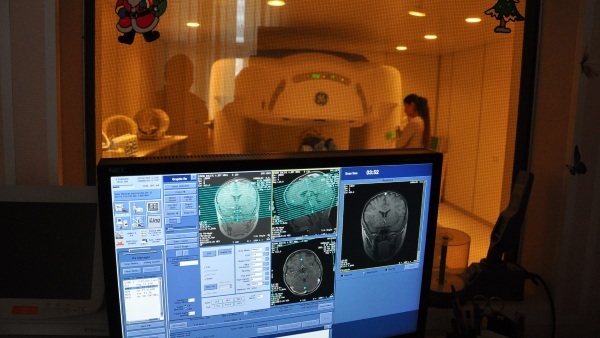
The patient must be examined by an otolaryngologist and a surgeon. Especially if rhinolalia has a congenital etiology, and its occurrence is caused by anomalies of intrauterine development.
At the stage of speech therapy diagnostics, the patient undergoes the following tests:
- Gutzmann test;
- checking the level of writing and reading;
- research of phonemic abilities;
- study of the prosodic aspect of speech;
- the ability to correctly pronounce consonants and vowels.
The end result of the diagnostic study is the preparation of a treatment plan with a possible the use of surgical intervention, as well as corrective work with a specialist in the field speech therapy. The average cost of a comprehensive examination is 7-8 thousand. rub.
When to see a doctor
A visit to a doctor should take place in the first 1-2 days after the child has been found to have signs of rhinolalia.
An alarming symptom should be a delay in speech development, the absence of phonetic activity in the form of sound reproduction, pronounced nasal voice, conversation with the compilation of illegible phrases and sentences, the presence of anomalies in the development of the oral cavity and nasal channels.
The first specialists who should examine the child are the pediatrician and speech therapist.
After that, doctors of other specialized specialties can be involved in the diagnosis. Delay in visiting a doctor can cause complications, irreversible changes in the anatomical structure of the palate and oral cavity, and the appearance of psychological complexes.
Modern medicine allows for effective surgical treatment of rhinolalia in the first days after the birth of a child. Especially if the occurrence of pathology is associated with anomalies of intrauterine development of the fetus.
Prevention
Basic preventive measures should be taken by women who are pregnant. Maintaining a healthy lifestyle, following the recommendations of a gynecologist, minimizes the risk of having a baby with signs of rhinolalia.
In this case, the following prevention rules must be observed:
- balance the diet, eating only biologically healthy foods;
- refrain from drinking alcoholic beverages, smoking, taking drugs;

- protect yourself from the effects of stressful situations, prevent psychoemotional overstrain;
- avoid contact with chemicals that have a toxic etiology;
- provide the body with good rest, which should last at least 8-9 hours a day;
- throughout the entire period of pregnancy, provide the body with moderate physical activity (for the development of the fetus is positively influenced by walking in the fresh air, performing gymnastic exercise);
- do not lift objects weighing more than 3 kg.
The emergence of a congenital type of rhinolalia can be associated not only with the negative influence of environmental factors, but also with poor heredity. A man and a woman planning to have a child must donate blood for genetic testing and a predisposition to pathologies of the oral cavity and nasal canals.
Treatment methods
Successful therapy of rhinolalia is impossible without the elimination of defects in the speech apparatus using the method of surgical intervention.  Only after the correct anatomical structure of the nasopharynx is restored, the speech therapist begins to treat the patient.
Only after the correct anatomical structure of the nasopharynx is restored, the speech therapist begins to treat the patient.
Surgery
There are several ways to correct the abnormal development of the nasopharynx with surgery.
Depending on the specifics of the pathological state of the speech apparatus, the following methods of surgical intervention can be used:
- manufacturing and further installation of an individual pharyngeal obturator, which eliminates the defects of the underdeveloped palate, restores the functional activity of its muscles;
- uranoplasty, which consists in performing tissue plastics with the closure of the cleft palate (this is an operation that is indicated for children born with a cleft palate);
- cheiloplasty to close the cleft lip (cleft lip syndrome);
- polytomy of the nose, aimed at surgical removal of the adenoids;
- septoplasty, the result of which is the alignment of the deviated nasal septum (the procedure is aimed at restoring normal air circulation and eliminating the nasal effect);
- removal of extraneous neoplasms with excision of benign and oncological tumors.

Rhinolalia in speech therapy is a disease that should be treated as early as possible. The maximum therapeutic effect of a surgical operation is achieved if it was performed on a child before reaching 3 years of age.
Speech therapy exercises
After the completion of the stage of surgical treatment, a speech therapist enters the work.
Depending on the type of rhinolalia, the following types of speech therapy techniques can be used:
- automation of vowels and consonants, when the child reproduces them several times during the allotted period of time;
- development of phonemic hearing, which is carried out under the guidance of a speech therapist;
- replenishment of vocabulary by daily learning of new words;
- development of nasal and oral expiration, if these functions were absent before the operation;
- training in the correct formation of sentences and phrases;
- development of voice power, which was previously suppressed by a defect in the vocal apparatus.
Depending on the type of rhinolalia in the process of restoring normal speech, take-off and landing exercises, a needle, a metronome, and a boa constrictor can be used. The type of training of the speech apparatus is selected by the speech therapist on an individual basis.
Psychological and psychotherapeutic assistance
The provision of psychological and psychotherapeutic assistance is aimed at ensuring that the patient regains self-confidence, is not afraid to communicate with people around him, and increases his self-esteem.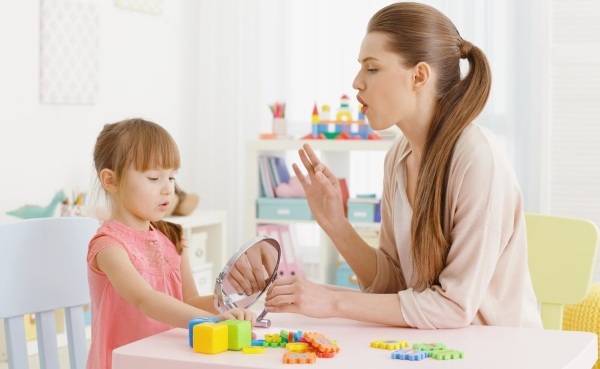
For this, the psychologist conducts explanatory work, telling that a surgical operation and classes with a speech therapist completely restored speech functions without signs of nasal and other phonetic defects. Psychological assistance is especially important for adolescent children who have undergone treatment as adults, have complexes and fear of communicating with others.
Other methods
An additional method of restoring the normal functions of the speech apparatus is the implementation of massage of the scars that formed after the surgical operation.
It is necessary to perform smooth circular movements, with the help of which the improvement of local blood circulation is ensured, the formation of fibrous tissue is prevented. The average duration of a physiotherapy procedure is 15 minutes. in a day.
Possible complications
In the absence of a full diagnosis and further treatment aimed at restoring the functions of the speech apparatus, the development of the following complications and negative consequences that are caused by rhinolalia:
- deterioration of speech and the transition of the disease to the 4th most severe stage;
- complete loss of speech activity with the inability to build legible phrases and sentences;
- the need to use facial expressions or sign language;
- further changes in the anatomical structure of the palate or other parts of the oral cavity and nasopharynx;
- overgrowth of polyps and other extraneous neoplasms, if rhinolalia was caused by their presence;
- the emergence of severe psychological complexes due to the fear of talking with people around and the panic fear of being ridiculed;
- impossibility of social adaptation, family creation, employment for a good job;
- the spread of metastases of a malignant neoplasm, if initially the defect of the speech apparatus was caused by a tumor in the oral or nasal cavity.
Rhinolalia is a separate disease in speech therapy, which is characterized by impaired speech functions with the manifestation of signs of nasalism, muffledness of the timbre of the voice, incorrect reproduction of sounds. This pathology can be congenital or acquired in origin.
In most cases, the development of the disease is caused by defects in the intrauterine formation of the palate, nasal canals, and larynx. Treatment of this disease includes the use of surgical methods, classes with a speech therapist and a psychotherapist. With the timely initiation of therapy, the prognosis for speech restoration is favorable.
Rhinolalia video
Reasons and types of rhinolalia:

